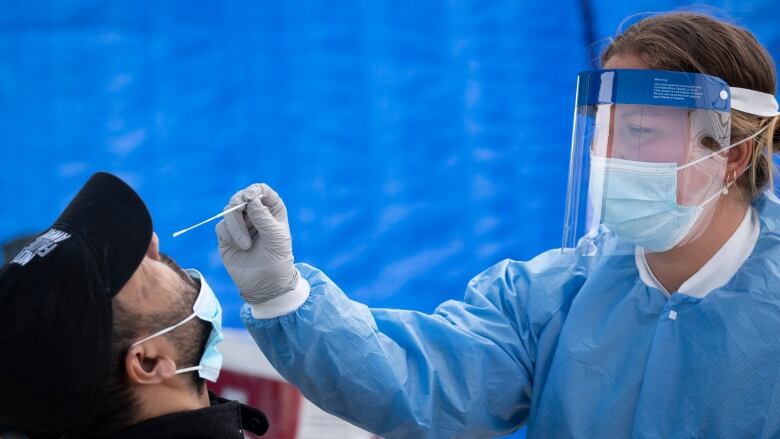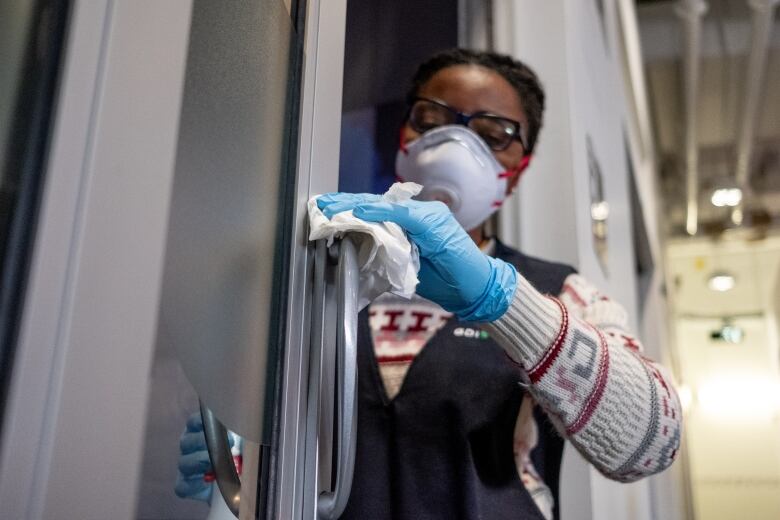COVID-19 is changing the way men and women split the risk in the workplace
Pandemic is shifting more risk to female-dominated professions

In Canada, the most dangerousoccupations from logging and fishingto farming and construction have always been,and remain,male-dominated.
Female roofers, truck drivers, ironworkersand miners exist, of course, but they'restill rare.Women are over-represented in indoor jobs that tend to be considerably safer.
In 2018 the last year for which we have full statistics 1,027 Canadians died on the job. All but 30 of them were men.
But thanks to a pandemic that has made many female-dominated jobs and professionsmuch more dangerous, the outdoors is suddenlythe saferplace to work.
Service-oriented trades that tend to employ a lot of women such as health care, education and retail also involve a lot of interaction with the public.
That means aheightened risk of exposure to the virus that causes COVID-19. That heightened risk may be showing up in the caseloadstatistics now.
Unequal threats
In every age demographic but one (60 to69 years), the number of women being diagnosed withCOVID-19 slightly exceeds the number of male victims.
The demographicwith the largest number of COVIDdiagnoses in Canada is women aged 20-29 15,177 cases, or 51.3 per cent of the total. And although the disease is generally thought to be more severe in men, more than half of thoseunder the age of 40 being hospitalized withCOVID-19 in Canada arewomen.
But it's still not clear and itmay never be how many of those infections came from work.
No field of work is more exposed to the risk of infection than the health care sector, which is about 80 per cent female.
Women make up over half of all family doctors and general practitionersand 90 per centof all nursesin Canada.Six out of every ten pharmacists, seven often psychologists and eight outof ten physiotherapists in Canadaare women.
Not only is the health care sectordominated by women, it's alsotheonly fieldof work wherewomen run a higher risk of workplace injurythantheir male colleagues, according to the federal government's Canadian Centre for Occupational Health and Safety.
Health care workers at risk
A study released this week by the Canadian Federation of Nurses' Unions (CFNU) revealed that13,000 workplace injury claimsrelating to COVID-19 exposure have been filed alreadyby Canadian healthcare workers.
"Nationally, health care workers comprise almost 20 per cent of all COVID19 infections in Canada,about double the global health care worker infection rate," says the report.
The report describes what it calls a series of over-confident and erroneous assumptions by senior medical staff and administrators that led to healthcare workers lower down the chain being left under-protected.
The irony is obvious especially when you recall thatLinda Silas,president of the CFNU, questioned early onthe assumption being made by many health officialsthat COVID-19 spreads through droplets but not aerosolized particles.
"When we do not know, we have to go for the best precautions for workers," she said in mid-February. It would be months later before all health care workers began to receive the personal protective equipment (PPE) they needed.
Who gets defined as a health worker?
Canada's official count ofhealth care workers who have died of the novelcoronavirus stands at 12, although unions place the number at 16.
COVIDfatality rates for health workers might be higher "if we had a better definition of who they are," said Ivy Bourgeault, aresearch chair in Gender, Work and Health Human Resources at the University of Ottawa's Telfer School of Management.

"I think when you look at exposed workers in housekeeping, I think of them as health workers because they're helping to keep those places clean and healthy," she said. "But the data typically don't capture people in sanitary and dietary roles."
The pandemic alsohas hitother sectors that employ a lot of women,such as retail, restaurants and hospitalityandeducation.
Ontario, which has seen a steeprise in new cases in recent weeks, has just imposed stricter measures in three regions that banindoor dining at restaurants and barsand closegyms, movie theatres and casinos.

Health measures have improved at supermarkets and grocery stores since the early days of the pandemic, when many employers following government advice at the time told theiremployees not to wear masks at work.
Canada-specific data is lacking but the United Food and Commercial Workers Union, which represents 1.3 million workers in the U.S. and Canada, said that 82 of its members who worked in U.S. grocery stores and supermarkets diedduringthe first 100 days of the pandemic, while more than 11,000 were sickened over that time.
But the union, which also represents workers in the food processing industry, reported even more deaths and infections among members who didn't work in grocery stores or supermarkets.
It's a reminder that COVID-19 has no gender preference only vectors.
"Some of the deaths are in industries where males predominate," saidBourgeault. "Meat-packing plants and migrant farm workers, for example. Those outbreaks disproportionately affect men rather than women."
So on balance, saidBourgeault, "I don't think we're going to see a massive increase in deaths that would cause a shift in the gender-based trends that we see in work-related deaths."
In fact, COVID typically hits men harder than it doeswomen which helps toexplain why men outnumber women in the number of COVID fatalities in every decade of workinglife. In the 60 to 69 age demographic, for example,427 men and 259 womenhad died of COVID in Canada as of Oct. 8.
It's only in theover-80 age demographic that you start to seethe number of women dying outstrip the number of male victims 3,995 women and2,723 men.(Most of those who have died ofCOVID-19in Canada have been well past working age; fewer than 1,000 Canadians aged 20 to70 have died.)
To approach the number of men who die on the job in even a normal year, all of COVID's working-age victims of 2020 would have to be femaleand all of theirinfections would have to be acquired at work.
Bourgeaultsaid she does expect COVID to change the relationship some female workers have with their employers.
Workers who take risks expect to be compensated for them.Many Canadian grocery and retail chains introduced small pay premiums (typically $2 perhour) in the early days of the pandemic.
'We have a chance to fix this'
In June, theLoblaws, Walmart and Metro grocerychains halted those pay hikes. Jerry Dias, president of theUnifor union, condemned the move.
"The fact is, the pandemic did not make these workers essential and did not create the inequities in retail," Dias said. "It simply exposed them.
"We have a chance to fix this. We can't let this opportunity pass."

Bourgeault said unions are nowtaking an interest in the plight of theunderpaid workers (most of themfemale)facing a heightened workplacethreat due toCOVID-19 workersthose unions don't alwaysrepresent.
"I see that there has been a lot of solidarity amongst unions that don't necessarily cover personal support workers or have them as members," she said.
"Unions become much more relevant to workers when they feel they are not respected, kept safe, and remunerated appropriately.And all three of those things are happening now."
She said she's encouraged to see governments support pay increases for personal support workers that would raise the status of a traditionally female-led occupation.
"If this kind of work is 'essential,'then it should be much better remunerated."












_(720p).jpg)


 OFFICIAL HD MUSIC VIDEO.jpg)
.jpg)



























































































